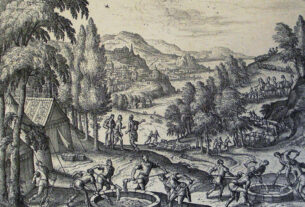The mishnah on today’s page states:
One who did not see the celebration of the place of the drawing water never saw celebration in his days.
That’s right, you haven’t partied until you’ve partied in the Temple on Sukkot. The mishnah then describes the bash in lengthy detail:
At the conclusion of the first festival day the priests and the Levites descended to the women’s courtyard (a lower courtyard open to the Israelite public) … There were golden candelabras atop poles there in the courtyard. And there were four basins made of gold at the top of each candelabrum. And there were four ladders for each and every pole and there were four children from the priesthood trainees, and in their hands were pitchers with a capacity of 120 log (about 15 gallons) of oil that they would pour into each and every basin … And the light from the candelabras was so bright that there was not a courtyard in Jerusalem that was not illuminated.
The pious and the men of action would dance with flaming torches that they would juggle in their hands, and they would recite passages of song and praise to God. And the Levites would play on lyres, harps, cymbals, and trumpets, and countless other musical instruments. The musicians would stand on the fifteen stairs that descend from the Israelites’ courtyard to the women’s courtyard, corresponding to the fifteen Songs of the Ascents (Psalms 120–134) and upon which the Levites stand with musical instruments and recite their song.
Candelabras (the Gemara says they were 50 cubits — about 75 feet high) on poles to illuminate not just the courtyard but the whole city! Pyrotechnics! Dancing! Juggling! Instruments! Chanting! Can you even imagine?
The mishnah’s claim that one who never saw this Sukkot blowout at the Temple had never really experienced a celebration at all turns into a game of “you’ve never lived until…” in the Gemara. Here are a few other superlatives to be found on today’s page:
One who did not see Jerusalem in its glory, never saw a beautiful city. One who did not see the Temple in its constructed state, never saw a magnificent structure.
The Gemara specifically describes the Second Temple which, we are told, Herod built out of differently colored marble intentionally offset to resemble the appearance of waves of the sea. Stunning!
Jerusalem doesn’t get all of the praise here. Listen to Rabbi Yehuda’s thoughts about the great synagogue in Alexandria, Egypt:
Rabbi Yehuda says: One who did not see the great synagogue of Alexandria in Egypt never saw the glory of Israel. They said that its structure was like a large basilica with a colonnade within a colonnade. At times there were six hundred thousand men and another six hundred thousand men in it, twice the number of those who left Egypt. In it there were 71 golden chairs, corresponding to the 71 members of the Great Sanhedrin, each of which consisted of no less than twenty-one thousand talents of gold. And there was a wooden platform at the center. The sexton of the synagogue would stand on it, with the scarves in his hand. And (because the synagogue was so large and the people could not hear the communal prayer) when the prayer leader reached the conclusion of a blessing requiring the people to answer amen, the sexton waved the scarf and all the people would answer amen.
Can you even imagine such beauty and extravagance? A synagogue so large and crowded one cannot hear the service and must rely on signals from colored scarves to know when to say amen? It seems that the synagogue was so large and bustling it was not just a place to praise God, but also a good place to network:
And the members of the various crafts would not sit mingled. Rather, the goldsmiths would sit among themselves, and the silversmiths among themselves, and the blacksmiths among themselves, and the coppersmiths among themselves, and the weavers among themselves. And when a poor stranger entered there, he would recognize people who plied his craft, and he would turn to join them there. And from there he would secure his livelihood as well as the livelihood of the members of his household.
The ancient world held many marvels, but so does our own. What would you say is on your contemporary list of “you haven’t lived until you’ve…”?
Read all of Sukkah 51 on Sefaria.
This piece originally appeared in a My Jewish Learning Daf Yomi email newsletter sent on August 27th, 2021. If you are interested in receiving the newsletter, sign up here.
The post Sukkah 51 appeared first on My Jewish Learning.




